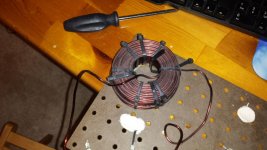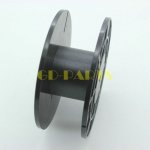have at hand one xover inductor near 2mH or higher
Is there any power loss?
In these measuring FFT I biased the SIT with "more or less" 1.6A in CCS and 18V at drain (this voltage varies due to CCS usage, according to bias). Is an fair bias point, with 2H>3H and more stability/less change for different loadsHi, your output spectrum is very promising. It nice to see that I am not the only one to use the floor as a laboratory table.
Claudio
Hmmmm.... The ground helps with heatsinking, and not vibrates like an shelf😀!😎
Is there any power loss?
I would think not, assuming your inductor's DCR is no worse than
the resistor it's replacing.
I imagine something like this will work quite nicely...
156B Hammond Manufacturing | Mouser
Dennis
Iron-core over air-core? Would the air core need to be a larger gauge to avoid saturation? How's that work?
thanks,
Vince
thanks,
Vince
For example, your garden variety 18 AWG 2mH air core will have a DCR in the neighborhood of an ohm or less. Higher gauge will have lower DCR. Air core has no core to saturate.
The iron core coil referenced has high enough current capability that it will not saturate under these conditions. Choose like wine 🙂
The iron core coil referenced has high enough current capability that it will not saturate under these conditions. Choose like wine 🙂
Last edited:
For example, your garden variety 18 AWG 2mH air core will have a DCR in the neighborhood of an ohm or less. Higher gauge will have lower DCR. Air core has no core to saturate.
Thanks Mike, I saw 18ga with less than 1 ohm DCR and 300w capable for less than $20 each. That's why I asked about saturation. Is saturation a power handling issue? I'm not sure...maybe I should Google it and not ask boring questions. 😉
Thanks
Vince
Speaking of wine, it's almost Papa's birthday. 🙂
How shall we celebrate? 🙂
I mentioned the Hammond since I remember them from my ill-fated Aleph-X
attempt. There the current draw is sufficiently high you really would want to
keep the DCR down. With a DCR budget of 1 ohm, lots more choices are
available.
Dennis
attempt. There the current draw is sufficiently high you really would want to
keep the DCR down. With a DCR budget of 1 ohm, lots more choices are
available.
Dennis
Remember DC is opposite to AC in magnetic terms. More turns in DC significates more induction, so if inductor is near saturation/saturated is an simple matter to unwind some turns... not much to loose so much inductance ( = formula plus turns squared)
I used an air cored choke (the round cooper thing in my photo from "ground table lab"), but it must to be far from input, thanks to great magnetic leakage (and solenoid chokes also will have magnetic leakage, the magnetic path is open). Is easy to experiment with positions before fixing them in the chassis (and making some holes). Even with small spaces is possible to find some silent position.
Hmmm... Papa's birthday? 😎😎😎
I used an air cored choke (the round cooper thing in my photo from "ground table lab"), but it must to be far from input, thanks to great magnetic leakage (and solenoid chokes also will have magnetic leakage, the magnetic path is open). Is easy to experiment with positions before fixing them in the chassis (and making some holes). Even with small spaces is possible to find some silent position.
Hmmm... Papa's birthday? 😎😎😎
1mH will have 0R75 reactive at 120Hz; in 240Hz is already superior to 1R alternative, so maybe is worth testing them. One alternative is: mantain the 1R resistor, in series with inductor (if dcr from inductor is not much high to loss so much voltage), and will got good results.
Alas, since LC circuits tend to resonate, damping them with an series resistance, reducing the Q factor, removes oscillatory possibilities (this is not an problem with CCS loaded amp, because SIT do not interact with supply).
Alas, since LC circuits tend to resonate, damping them with an series resistance, reducing the Q factor, removes oscillatory possibilities (this is not an problem with CCS loaded amp, because SIT do not interact with supply).
PS.: With that wire size I don't expect much rdc...Thought I had one on hand but it's only 1.0 mH. Yabba! 😀
About PSU oscillating, I read about it in Patrick Turner website, and saw something about it on Tubelab website, but I never see this in practice (maybe why I not abuse my projects so much)
Last edited:
With that wire size I don't expect much rdc...
The whole thing is ironic. Even for speakers, is that size wire gauge necessary?
It's at least 10ga. Yes, probably not enough DC resistance. 😀
Just thought it was funny to show that coil. 🙂
The 2mH coil I used have an #12 gauge wire, and warms with the 3.2Adc drained from stereo SIT amp, reminding cooper have resistance, too😀
When people see the REAL wire size in every loudspeaker voice coil, and internal aluminium bond wires in semiconductors chips, or even secondary wires in most trafo coupled outputs, starts wondering about monster cable interconnects or suchlike...😱 but of course high rdc in cable plus inductors will play havoc in crossover based speakers, and losses some power
When people see the REAL wire size in every loudspeaker voice coil, and internal aluminium bond wires in semiconductors chips, or even secondary wires in most trafo coupled outputs, starts wondering about monster cable interconnects or suchlike...😱 but of course high rdc in cable plus inductors will play havoc in crossover based speakers, and losses some power
starts wondering about monster cable interconnects or suchlike...
Yes, exactly! I recently traded out my AudioQuest Indigo speaker cable approx. 10 or 12ga for .99/ft QED 14ga (looks like white lamp cord) speaker cable and there's more bass definition with the QED. There's more to than meets the eye.
Ok, thanks for the replies.
air core inductor is nice topic, i think that is the easiest compenent/part that can be build compared to resistor or capacitor.
i just ordered the machine for handwound, also plastic bobbin 80x32mm. it seems that i can get 2mH with 14awg, it's time to play with it
i just ordered the machine for handwound, also plastic bobbin 80x32mm. it seems that i can get 2mH with 14awg, it's time to play with it
Attachments
Has anyone made a spice model for the 2SJ28 from curves? I have been using MR's original model which was just his 2SK82 model switched around.
Thanks
** 2SJ28 ************************************************************
*M. ROTHACHER
*--------------------------------------------------
.SUBCKT 2SJ28 1 2 3 ; Drain Gate Source
+ PARAMS: MU=4.9140 EX=2.352 KG1=101.25 KP=75.0 KVB=24.0 VCT=7.04 RGI=2MEG
*--------------------------------------------------
E1 7 0 VALUE={V(3,1)/KP*LN(1+EXP(KP*(1/MU+(VCT+V(3,2))/SQRT(KVB+V(3,1)*V(3,1)))))}
RE1 7 0 1G
G1 3 1 VALUE={(PWR(V(7),EX)+PWRS(V(7),EX))/KG1}
RDS 1 3 1G ; TO AVOID FLOATING NODES
D1 2 5 DX
R1 5 3 {RGI}
.MODEL DX D(IS=1N RS=1 CJO=10PF TT=1N)
.ENDS
*--------------------------------------------------
Thanks
** 2SJ28 ************************************************************
*M. ROTHACHER
*--------------------------------------------------
.SUBCKT 2SJ28 1 2 3 ; Drain Gate Source
+ PARAMS: MU=4.9140 EX=2.352 KG1=101.25 KP=75.0 KVB=24.0 VCT=7.04 RGI=2MEG
*--------------------------------------------------
E1 7 0 VALUE={V(3,1)/KP*LN(1+EXP(KP*(1/MU+(VCT+V(3,2))/SQRT(KVB+V(3,1)*V(3,1)))))}
RE1 7 0 1G
G1 3 1 VALUE={(PWR(V(7),EX)+PWRS(V(7),EX))/KG1}
RDS 1 3 1G ; TO AVOID FLOATING NODES
D1 2 5 DX
R1 5 3 {RGI}
.MODEL DX D(IS=1N RS=1 CJO=10PF TT=1N)
.ENDS
*--------------------------------------------------
A couple of really swell guys have sent me a few 2SK182ES, so I have some good ones now and I can give them some more serious attention.
Many thanks to my benefactors I'm not worthy 🙂
I'm not worthy 🙂
Many thanks to my benefactors
 I'm not worthy 🙂
I'm not worthy 🙂- Home
- Amplifiers
- Pass Labs
- L'Amp: A simple SIT Amp



